
Introduction
Earthquake Sound is a company best known for producing knock your socks off subwoofers and amplifiers for home theater. They also manufacture several lines of speakers, including the Titans. The Titan Tigris weighs 89 pounds each and stands nearly 5 feet high, with an MSRP of $9,500 per pair. They are certainly imposing speakers that look the part, and are priced to compete with the crème-de-la-crème of tower speakers. In this review we’ll see how they perform.
Specifications
- Design: Floor-standing, 4-Way, Ported Enclosure
- Drivers: One 1″ Silk Dome Super Tweeter, One 2″ Silk Dome Tweeter, One 8″ Midrange, One 8″ Woofer
- MFR: 25 Hz – 40 kHz
- Sensitivity: 89 dB ± 3 dB
- Nominal Impedance: 4 Ohms
- Crossover frequency: 350 Hz, 3.2 kHz, 10 kHz
- Recommended Amplifier Power: 100 – 500 Watts RMS
- Dimensions: 50.5″ H x 9.8″ W x 18.3″ D
- Weight: 89 Pounds/each
- Available Finishes: Gloss Black
- MSRP: $9,500/pair USA
- Earthquake Sound
Design and Setup
The Titan Tigris speakers arrived via freight service on a pallet. I was barely able to wrestle the giant boxes inside the house, and there was no chance I could get them upstairs to my listening room without the help of a friend. Once I got them upstairs, unpacking was straightforward due to excellent instructions provided on the outside of the box. The speakers come double-boxed with foam separating the two boxes. Inside the inner boxes, three pieces of foam secure the speakers, which come enclosed in a velvet bag. Cloth gloves are provided to prevent scratching the piano black lacquer finish during setup. The speakers need to be handled carefully to avoid damaging the top mounted tweeter enclosure. I found the gloves a bit slippery in trying to get a grip on the super smooth finish. I just removed my watch and wedding ring and moved them around with bare hands.
The Tigris is a very well made and handsome speaker. The sculpted and curved MDF case is finished in very high quality 3mm thick piano black lacquer paint, with silver colored trim encircling the drivers. Beefy, gold plated dual binding posts with gold plated copper jumpers allow for bi-wiring and bi-amping. The binding posts do accept banana plugs. No grilles are supplied, and there is nowhere to mount them, with the exception of the tweeter. A permanently mounted perforated grille protects the 1″ neodymium magnet silk dome super tweeter. The main tweeter is a 2″ silk dome with ball loading, and the midrange and woofer are Kevlar cone long excursion drivers 8″ in diameter. A port vents to the rear of the cabinet just above the binding posts. The base accepts four low profile carpet spikes, which are invisible once set up.
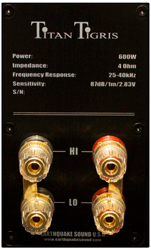
This speaker certainly needs to make no apologies when it comes to fit and finish, component quality and design. I have a small listening room, and from the look of the Tigris, it is obvious they are designed for big rooms that will encompass their very large sound production.
The speaker is rated at a nominal impedance of 4 ohms, with frequency response from 25 Hz to 40 kHz. In my room, I got good response down to 20 Hz, as we’ll see later.
I set up the speakers near the location where my Gallo Reference 3.1s normally live. This is about three feet from the sidewalls and four feet from the back wall of the listening room, with the speakers separated by about seven feet. I toed the speakers in toward the listening position, which I found to give the best imaging. I ended up moving my listening position about two feet farther back from normal to about twelve feet from the speaker plane to get away from room modes in the bass (more on this later). I broke in the speakers with several weeks of TV and home theater use before getting down to the listening tests.
In Use
I was a bit concerned about such a large loudspeaker in my modestly sized listening room (16′ x 21′ x 8′). This turned out to be an issue I struggled with throughout the entire review period. Initially, the sound was characterized by a seriously over-prominent mid-bass. The speakers were exciting room modes in the 100-200 Hz region. I moved my listening position two feet further back (to ten feet). This helped tame the excitation of the room modes, but did not completely solve the problem. I tried moving the speakers around a bit, but the room setup did not allow complete freedom in positioning. I think these speakers would work just fine in the mid-bass if you have a large room. Speakers of this size are not made for small rooms like mine, and the mid-bass is where the issue usually shows up.
Putting aside this room-size-caused-artifact, the performance of the Tigris was stellar. The tall speaker, with high mounted midrange and tweeter resulted in a very tall and expansive soundstage. This gave me some of the most realistically sized images I’ve heard in my room, with vocals sounding about the height of a standing person. The soundstage width did not give up much to my excellent Gallos, a great feat for a speaker with such a large cabinet. The soundstage plane was typically at or behind the location of the speakers, which added to the great amount of space created by the Tigris.

The bass extension on the low side of the mid-bass issue was excellent, offering very good weight and impact with extension to the lowest frequencies. The bass power was superior to my Gallos, with eye blinking transients. Extension on electronic music, like Orbital’s In Sides or Daft Punk’s Human After All, the bass extension and weight shook the inside of my stomach, as it should. The midrange had great smoothness and detail, with great extension provided by the pod-mounted tweeter. The introductory portion of Gomez’ Revolutionary Kind was probably the best I’ve heard, with great accuracy and realism to the drums, vocals, and acoustic guitar. Once the bass line came in, the mid-bass issue was apparent, but again, that is a problem caused by my small room. On Beth Orton’s Best Bit, the production on the vocals was clearly audible, making the detail offered by the Tigris a double-edged sword.
On all tracks, the dynamics presented by the speakers was exceptional. Not only were big transients delivered with shocking impact, the small scale dynamics that preserve the live quality of the music were there in spades. I haven’t heard that level of excitement in my listening room since I listened to the super high sensitivity Zu Druids. This is another feature I wouldn’t have expected in such a large speaker. Many big speakers struggle with dynamics without colossal amplification behind them.
What I heard from the Titan Tigris says that if you have a large room where the prodigious bass capability of these speakers can do their job, they will be certainly compete with the best $10k-$20k speakers. If you don’t have a big room, I would suggest caution. They might work for you, depending on how much furniture you have in there. If for example, you have a devoted music listening room, with just one or two chairs, wall and corner treatments, they could be terrific. Of course, this applies to any large speaker. On the other hand, if you are using the speakers in a home theater system, with just about any modern receiver, the built-in EQ, such as Audyssey, can flatten the response so that you don’t have that extra mid-bass.
On the Bench
The Titan Tigris was measured in my listening room using my M-Audio ProFire 610 Firewire audio interface with a calibrated Earthworks M30BX microphone and SpectraPlus FFT analysis software. Impedance was measured using a Smith and Larson Woofer Tester.
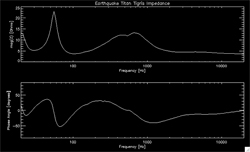
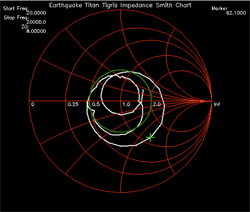
The impedance was measured from 20 Hz to 20 kHz and is presented as traditional stacked amplitude vs. frequency and phase vs. frequency plots and on a Smith Chart as I have described in previous reviews. The impedance of the Tigris is specified at 4 ohms. The impedance drops to this level over most of the audio band, but rises to well above 10 ohms at a peak around 55 Hz (revealing the port tuning) and at around 500 Hz. The wide variation in both the magnitude and phase of the impedance indicates that you will need an amplifier that has plenty of power, and the specs state a 100 watt RMS minimum.

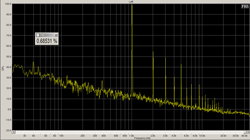

Total harmonic distortion measurements made at frequencies of 50 Hz, 1 kHz and 10 kHz show good results, similar to my Gallo 3.1s, but not quite as good as the Thiel 3.7s or Legend Tikandis I reviewed in the past.
The frequency response was measured at 1 meter on axis from a single speaker, both at midrange height and listening height and at the listening position with both loudspeakers. In both cases, the test tone was white noise.
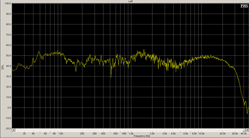
At 1m from the speaker and at the height of the midrange driver, the response shows broad response peaks at around 1.5 kHz and 80 Hz, or a response valley between 100 Hz and 1 kHz, depending on how you want to look at it.
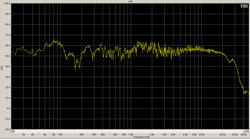
At listening height, the midrange peak is gone, but the peak at around 80 Hz still remains. It is exacerbated by a room suck-out (a null in the floor-ceiling standing wave) at around 150 Hz.
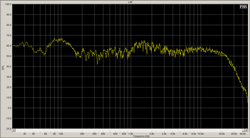
At the listening position, the bass is smoothed out, but the 1.5 kHz peak shows a little. A fairly prominent broad peak at 100 Hz is also visible.
Conclusions
The Earthquake Titan Tigris is proof-positive that the room and the speaker must be matched. In my small room, the speakers sounded uniformly fantastic, but with an overactive mid-bass. In a bigger room where the speakers won’t excite room modes to the same degree, these speakers will be absolutely wonderful and a serious player when compared to the similarly priced competition. Just be sure to try these out in your own room before you commit!


